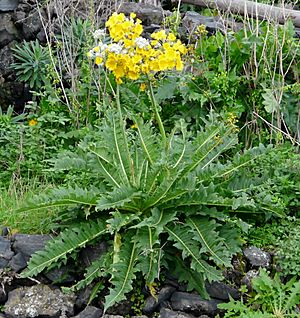Sonchus acaulis facts for kids
Quick facts for kids Sonchus acaulis |
|
|---|---|
 |
|
| Scientific classification | |
| Genus: |
Sonchus
|
| Species: |
acaulis
|
Sonchus acaulis is a special plant found only on the Canary Islands. It belongs to the daisy family, which scientists call Asteraceae. You can discover this unique plant growing on the islands of Gran Canaria and Tenerife.
Contents
What it Looks Like
This plant is a perennial, meaning it lives for more than two years. Its base is woody, like a small tree trunk.
Leaves and Stems
The leaves of Sonchus acaulis grow in a big circle close to the ground. This circle is called a rosette. It can spread out up to 1 meter wide! The leaves are deeply cut, almost like feathers, and feel a bit fuzzy or "wooly." Each leaf also has a pointy tip.
A tall stem, called a scape, grows from the center of the plant. This stem can reach up to 1.5 meters high. It doesn't have any small leaves, or bracts, on it.
Flowers
The flowers grow in a cluster at the top of the stem. This cluster looks a bit like an umbrella, which is called an umbellate shape. Each flower cluster has one or more flower heads. The stalks holding these heads are also fuzzy.
The parts that protect the flower bud, called involucral bracts, are wide. They are covered in very thick, white, wooly hairs. Each flower head is about 2.5 centimeters wide. They have many bright yellow ray flowers, which are the petal-like parts you see. However, they do not have disc flowers, which are the small flowers usually found in the center of a daisy.
Where it Grows
Sonchus acaulis is found in different areas on its home islands.
On Tenerife
On the island of Tenerife, you can find this plant in many places. It grows in forests and in dry, sunny areas called xerophytic zones. It's especially common along the northern coast, from the Sierra Anaga mountains to the Teno region.
On Gran Canaria
On Gran Canaria, this plant prefers mountain regions. You can spot it in places like Los Tiles de Moya, Tenteniguada, Cruz de Tejeda, and Roque Nublo. It typically grows at heights between 500 and 1600 meters above sea level. In these areas, it can be quite common.
See also
 In Spanish: Cerrajón de monte para niños
In Spanish: Cerrajón de monte para niños

